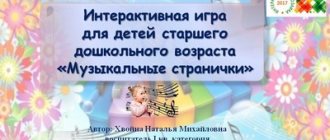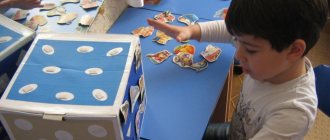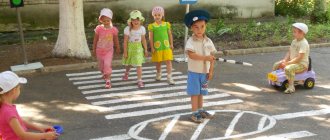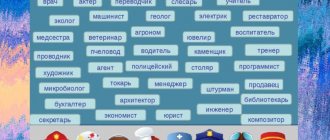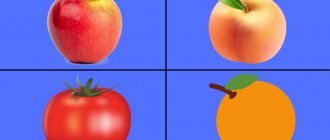Progress of the game:
children (2 people)
take turns taking
a picture , calling what is drawn on it
, determining when it happens. If in the fall , put the picture on the playing field
If at other times of the year, they put it aside. Next, for each picture, make up
sentence using the keyword " autumn "
.
Note: the game can be individual.
Didactic game “Wonderful bag”
.
Objectives: to improve the ability to identify a fruit or vegetable by touch by its shape,
correctly name its color, develop attention, memory, oral speech
Attributes: bag, dummies of vegetables and fruits.
Game "Autumn Gifts"
What the child will learn: distinguish between leaves, cones, nuts and acorns; use the words “more”, “one” in speech.
Equipment: tray, 4 saucers.
Progress of the game:
in late summer or early autumn, while walking with your child, invite him to collect a bouquet of leaves; collect cones, acorns or nuts in a basket.
Having brought these finds (3-4 pieces each) home, prepare to play with your child: put everything on a tray, carefully place it on it, and dry it.
Invite your child to put what he has collected into separate saucers, while commenting on the child’s actions: “Put the nut. Add another nut." (Ask your child to repeat after you: “Here’s another nut... Here’s another nut...”)
Continue: “Put the acorn here. Another acorn. And one more acorn...” Help the child arrange the cones and leaves.
Game "Treats"
What the child will learn:
correctly use masculine and feminine singular nouns in the accusative case without a preposition; answer questions that require a comparison of facts and a simple conclusion.
Equipment:
toys - hare, bear, squirrel; subject pictures.
Progress of the game:
Tell your child that today a bunny, a bear and a squirrel came to visit him. Offer to treat them to something tasty - something they love.
Place a carrot, cabbage, pine cone, acorn, pear, plum in front of the child. Ask: “What does the bunny like? What does the bear like? What does a squirrel like? What should we give the bunny? What should we give the bear? What should we give the squirrel? (For the bunny - carrots, cabbage. For the bear - a pear, plum. For the squirrel - a pine cone, an acorn.)
Why didn't the bunny get a bump? (Because he doesn't eat pine cones.)
Why did they give the bunny a carrot? (Because he loves carrots.)
Game "We are at the dacha"
What the child will learn:
see the difference between grass - trees - bushes; recognize their images; highlight branches and leaves of a tree; distinguish between the verbs “cuts - digs up”; understand simple stories; listen to an adult's story.
Equipment:
story picture.
Progress
of the game:
in early autumn, while walking with your child in the country (or in a park, square), start talking with him about what you see around him. Ask your child to show you a tree, bushes, grass.
If the child finds it difficult to do this, show him yourself; after a while, ask again to check how he understood and remembered what was shown. If the child
says a word, for example, “branch”, ask: “Where is the branch?” Constantly try to encourage your child's desire to talk.
After the orientation walk, look at the picture with your child. It depicts approximately what the child saw while walking around the dacha. Ask your child who is in the picture? (boy and girl). Invite your child to come up with names for a boy and a girl. (Try to choose names that consist of two identical syllables, for example Tata, Lyalya, or from different syllables, but with emphasis on the first syllable, for example: Nina, Nata, Tolya, etc.) Tell us what the boy is wearing ( jacket, boots, trousers), on the girl (scarf, jacket, skirt). Then offer to show it to him. Tell us that the girl is cutting flowers; that the boy is digging up potatoes.
Ask your child to show trees, bushes, grass, and flowers in the drawing. Tell your child: “You see, the wind is blowing dried leaves, shaking tree branches, windows are slamming from the wind, laundry is swinging on a line.”
Emotionally say: “The wind is blowing, blowing, blowing, blowing, tearing yellow leaves from the tree. The leaves are falling right under our feet.” Ask how the wind is blowing (“oooh”). Offer to draw a line with a pencil from one tree to another of the same kind; from one bush to another the same.
Game “Put it where I say”
What the child will learn:
distinguish prepositions expressing certain spatial relationships between two objects (on, in).
Equipment:
book, box, pieces of furniture (table, chair, sofa); any object (acorn, leaf, pebble).
Progress of the game:
Place the item you have chosen in front of your child. Ask the child to put this object where you say: on a book, on a table; on a chair; in a box, in a book.
Didactic game: “Autumn Adventure”, for children 4 - 7 years old
Author:Lyanguzova Olga Zhanovna
Position:
teacher - speech therapist
Place of work:
MKDOU No. 18, Miass, Chelyabinsk region
Purpose of the material:
the game can be used by specialists in working with preschool children aged 4 - 7 years, including for children with disabilities.
Equipment:
1 playing field, 9 pictures of leaves, 9 pictures of trees.
Goal:
development of observation, visual attention and memory
Objectives:
1. Activate children’s knowledge on the topic: “Autumn. Trees in autumn"
2. Develop the ability to form relative adjectives, develop basic mental processes.
3. Develop the ability to obey the rules of the game and play in a group of peers.
Form of organization:
individual or subgroup (2-3 people)
Preliminary work:
familiarization with the image of leaves and trees.
Progress of the game:
1 option
In front of the children there is a playing field of 9 sectors. Each sector contains 3 pictures depicting autumn leaves (chestnut leaf, oak leaf, willow leaf, aspen leaf, linden leaf, poplar leaf, rowan leaf, maple leaf, birch leaf).
The first move is determined by the counting rhyme:
"One two three four five.
We will collect leaves.
If you find a leaf,
I went first and played.”
If 3 children are playing, then each is given 3 pictures depicting single leaves.
The first player examines his leaves and the first sector on the playing field, if he finds among his leaves a similar one on the field, then he closes the sector with it and correctly names the leaf (chestnut leaf). Then considers the next sector. If the required sheet is not available, then the turn passes to the next player.
If there are 2 children playing, then we distribute 3 pictures to each and put 3 next to each other in a pile (with their shirts up) - “on the path.” The game is similar, but if the required sheet is not available, then it must be taken from the path. Only after this the turn passes to the other player.
The players' task is to get rid of their cards as quickly as possible.
The adult monitors the correct completion of the task and the formation of relative adjectives, correcting if necessary. If the child does not form the word correctly, he must stop and repeat the adjective correctly 3 to 5 times (maple, maple, maple)
Option 2
The game is played similarly to the previous one, with the only difference, instead of leaves, children are offered with images of trees. Thus, the task becomes more difficult, since children need to determine which tree the leaf comes from. In this version of the game, the child points to a leaf and introduces a relative adjective into the sentence: “A willow leaf from a willow tree.”
Making the game:
Word.
The picture material is taken from the Internet (links from sources are located below).
In the search engine we type the word CLIPART (picture on a transparent background) and the name of the picture. Select the required image, copy and paste it into the document. To remove the background, perform the following steps: WORK WITH THE DRAWING - REPAINT - SET A TRANSPARENT BACKGROUND.
So that the picture can easily move on the sheet, you need to click on the right mouse button, select OBJECT FORMAT - TEXT WRAP - BEFORE TEXT. The entire material can be downloaded from the “Download” link.
